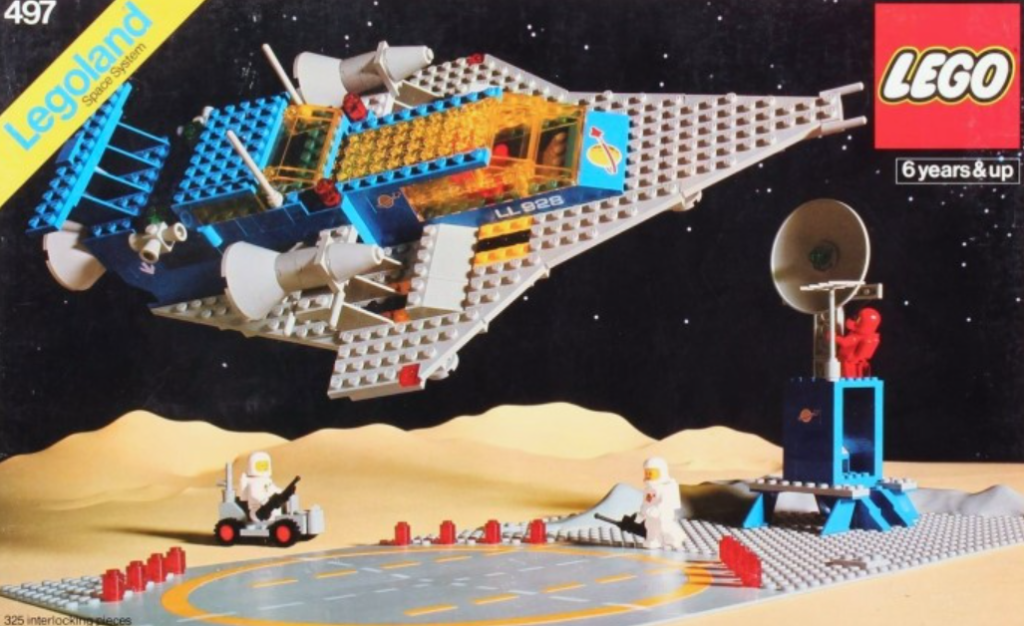The LEGO Classic Space theme
Launch Year: 1978
The LEGO Classic Space theme, launched in 1978, holds a special place in the hearts of LEGO enthusiasts. This theme introduced the iconic blue and gray spaceships, cheerful astronauts with smiling faces, and a universe brimming with exploration and adventure. At a time when space exploration was capturing the world’s imagination, LEGO Classic Space provided a tangible way for young builders to engage with the cosmos. The sets were revolutionary, not just for their design but for the way they inspired creativity and storytelling.

LEGO Classic Space Iconic Sets
LEGO Set – Galaxy Explorer (1979):

Arguably the crown jewel of the Classic Space theme, the Galaxy Explorer (Set 497 in the U.S., Set 928 elsewhere) introduced LEGO fans to a universe of intergalactic adventure. Featuring a spacious and sleek design, this spaceship included a highly detailed cockpit for two minifigures, retractable landing gear, and a detachable rover. Its innovative design embodied the futuristic spirit of space exploration during the late 70s and early 80s, paving the way for countless space-themed builds. The iconic blue and gray color scheme with the red and white spaceship accents became synonymous with Classic Space. This set remains a fan favorite and a sought-after item among collectors, even inspiring a modern remake in LEGO’s 90th anniversary celebrations.
LEGO Set – Space Cruiser and Moonbase (1979):

As one of the earliest space sets, the Space Cruiser and Moonbase (Set 487 in the U.S., Set 920 internationally) brought a whole new level of play to the Classic Space lineup. This set not only featured a sleek, detachable space cruiser but also came with a moonbase that included radar equipment and docking facilities, allowing for the construction of multiple configurations. The modularity encouraged builders to expand their space adventures by integrating other sets from the theme, fostering creativity and inspiring custom space missions. The moonbase also served as a key station for exploration and research on alien terrains, making this set a standout for imaginative, story-driven play.
LEGO Set – Alpha-1 Rocket Base (1980):

The Alpha-1 Rocket Base (Set 483 in the U.S., Set 920 elsewhere) brought space exploration to a new level with its impressive rocket and launch pad. This set stood out for its moving parts, such as the rotating launch pad, radar dish, and control center with intricate details that added a sense of realism. Equipped with a rocket and a support vehicle, the set allowed for thrilling space mission setups. Builders could simulate launching rockets into space, adding depth to their LEGO space adventures. The Alpha-1 Rocket Base remains one of the more complex Classic Space sets, exemplifying LEGO’s innovation during the early 80s.
Legacy of LEGO Classic Space
The LEGO Classic Space theme is more than just a series of sets; it’s a cultural touchstone that has influenced generations of builders. Its legacy can be seen in the continued popularity of space-themed LEGO sets and the fond memories it evokes among those who grew up with it. The cheerful astronauts and their adventures in the vast expanse of space continue to inspire new generations, proving that the spirit of exploration and creativity is timeless.
LEGO Classic Space remains a nostalgic and influential theme, cherished by both collectors and new generations of builders. The enduring popularity of LEGO Classic Space is a testament to its timeless appeal and the lasting impact it has made on the world of building. Its iconic sets, such as the Lunar Lander and Galaxy Explorer, have become beloved symbols of imagination and creativity. The theme’s launch in 1978 marked the beginning of a new era in LEGO history, capturing the hearts of both children and adults alike. Even today, LEGO Classic Space continues to inspire builders of all ages, reminding us that the wonders of the universe are just waiting to be explored.
